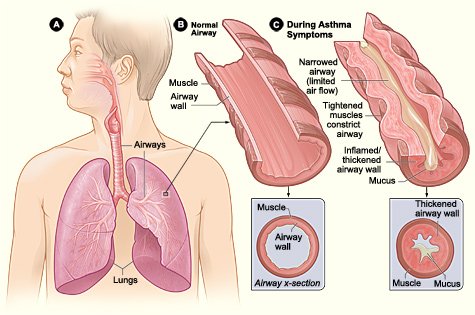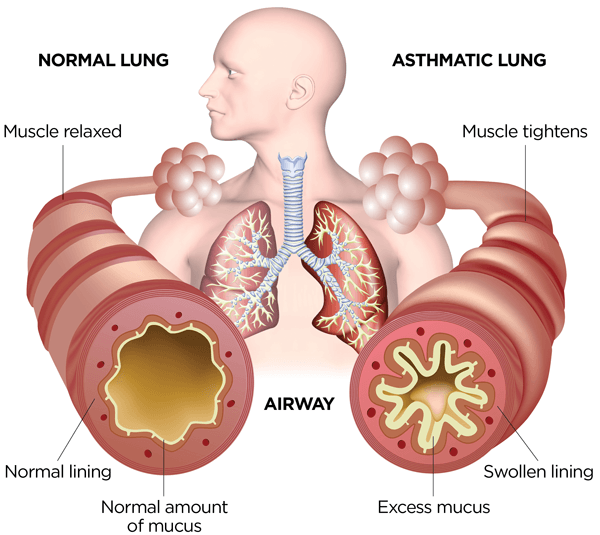Definition of Asthma – This course is designed to understand the concept of community health nursing: nurses’ roles and interventions in family health, school health, occupational health, environmental health, elderly health care, gender issues, disaster management and principles and terminology of epidemiology. The aim of the course is to acquire knowledge and skills in community health nursing.
Definition of Asthma
Asthma is a chronic inflammatory disease of the airways that causes airway hyperresponsiveness, mucosal edema, and mucus production.
Or,

Asthma is an intermittent reversible, obstructive airway disease in which the trachea of bronchi respond into a hyperactive way to certain stimuli.
Classification of bronchial asthma:
1. Acute bronchial asthma
2. Chronic Bronchial asthma
Causes/Precipitating Factors of Bronchial Asthma
- Childhood infections, eg. respiratory syncytial virus
- Indoor pollution
- Dietary deficiency of antioxidants
- Allergen exposure, eg. Pollen, dust, house mites, household pets, animal dander. feathers of
- pillows, specific food,
- Exercise, emotion, environment (cold) NO2, SO2, ozone, pollutants.
- Exposure to pets in early life
- Respiratory tract infection.
- smoking
- Occupation: Industrial chemicals, organic materials
- Anxiety, psychological
- Drug: Aspirin, Beta-blockers, NSAIDs.
(Ref by-Davidsons/224/677)
Pathophysiological condition of Bronchial Asthma
The underlying pathophysiology in asthma is reversible and diffuse airway inflammation that leads to airway narrowing.
1. Activation. When the mast cells are activated, it releases several chemicals called mediators.
2. Perpetuation. These chemicals perpetuate the inflammatory response, causing increased blood flow, vasoconstriction, fluid leak from the vasculature, attraction of white blood cells to the area, and bronchoconstriction.
3. Bronchoconstriction. Acute bronchoconstriction due to allergens results from a release of mediators from mast cells that directly contract the airway.
4. Progression. As asthma becomes more persistent, the inflammation progresses and other factors may be involved in the airflow limitation.
Management of Bronchial Asthma:
Clinical Features
Symptom
- Severe respiratory distress – dyspnoea
- Cough
Sign’s
A. G/E (General examination)
a) Patient is in upright position fixing the shoulder girdle
b) There may be central cyanosis
c) Pulse
- Tachycardia
- In severe case bradycardia
- Pulses paradoxus
d) Sweating
B. Respiratory system
a) Inspection
- Rate of respiration
- There are signs of respiratory distress
b) Palpation
- Chest wall movement: Symmetrically diminished
- Chest wall expansion: Reduced
- Vocal fremitus: Symmetrically diminished
c) Percussion: Hyper resonant on both sides
d) Auscultation
- There is vesicular breath sound with prolonged expiration on the both sides
- There are high pitched inspiratory and expiratory rhonchi
- There may be silent chest

Treatment
- Immediate hospitalization.
- Patient kept in propped up position.
- O2 should be given at a highest conc, available usually 60%. Then conc. should be adjusted according to the arterial blood gas measurement.
- 32 adrenoceptor agonist:
• Nebulised salbutamol (4.5-5mg) or Terbutalin (5-10mg). It should be repeated within 30 minutes, if necessary.
- Injection Hydrocortisone 200mg IV or tablet, Prednisolone 30-60mg orally
- IV drip with 5% dextrose in aqua 30 drops/min.
- All patients should be closely supervised O, therapy continued.
- If features of severity persists:
• Ipratropium bromide 0.5mg
• Aminophylline 0.5mg/kg/hr
• Nebulised salbutamol 4.5-5mg every 15-30min, if necessary
• Inj. Hydrocortisone 200mg IV
- Mechanical ventilation as a lifesaving procedure in few cases.
(Ref by-Davidsons/224/677)
Suppurative Lung Diseases
Suppurative Lung Disease:
1. Lung abscess.
2. Bronchiectasis.
3. Empyema thoracic
Causes of Purulent Sputum:
1. Lung abscess.
2. Bronchiectasis.
3. Empyema thoracic.
4. Klebsiella pneumonia (suppurative pneumonia)
5. Acute bronchopneumonia (lobular pneumonia)
6. Acute-bronchitis.

Sputum of suppurative lung disease:
1. Amount in 24 hours: Increased.
2. Character: Purulent, Not sticky.
3. Odour: foul smelling.
4. Colour: Yellow, green brown.
5. Viscosity: Intermediate viscid.
6. Relation to posture: change in posture induce sputum production.
Read more:
